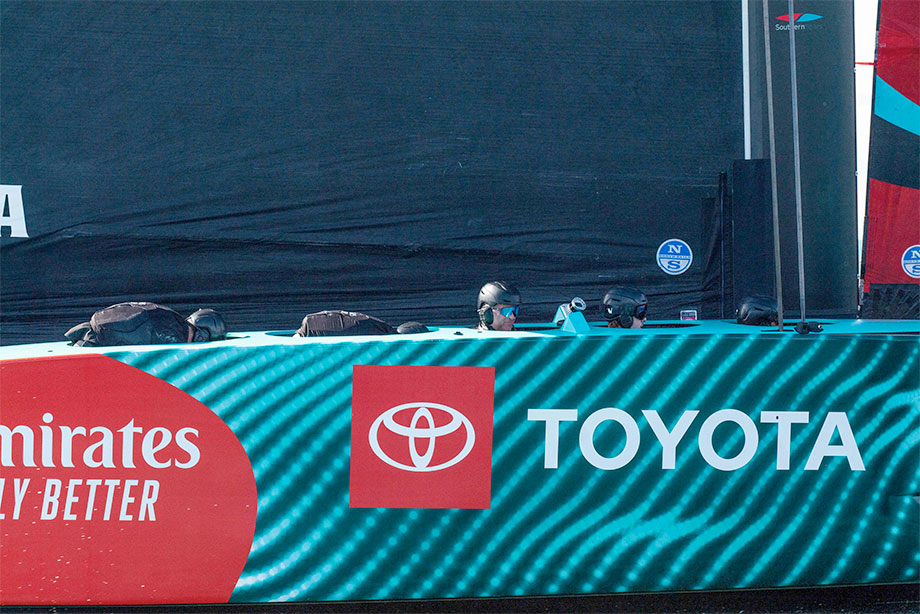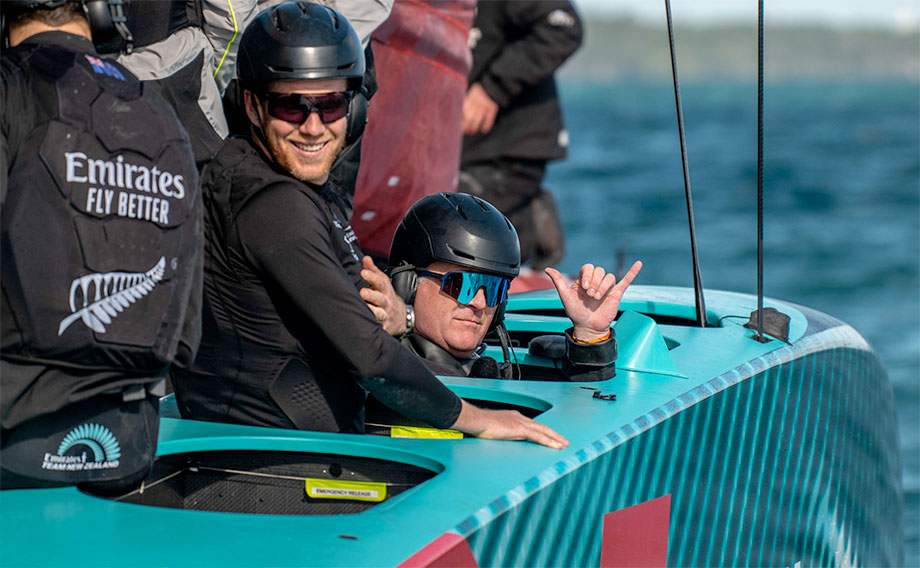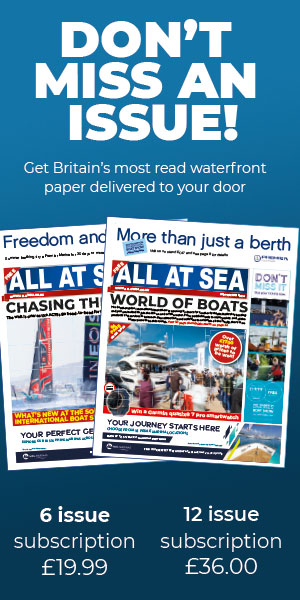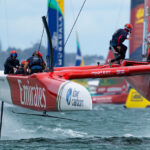The opportunity for a non-professional sailor to ride aboard an AC75 is, undoubtedly, a once-in-a-lifetime experience and something so scarce in sailing to be almost unfathomable. So tight are the America’s Cup testing and training schedules that teams simply cannot afford that most precious of commodities, time, in a campaign. Joyriders, it would seem, have no place in the America’s Cup.
So, when the mooted chance arose, in a scheduling window that was highly weather dependent before Emirates Team New Zealand de-camped to Barcelona for the European summer sailing season, the brief matter of some 23 hours of flying and a 19,674-kilometre journey from Cowes to Auckland was the only barrier. Trifling in comparison to the opportunity.
It’s the end of summer here in New Zealand and the arrival into Auckland International was hairy to say the least. An aborted, bumpy landing on an Emirates Airbus A380 and what’s called a ‘Go Around’ in aviation parlance gave a distinct clue as to what the conditions were going to be like in this sailing city and, more importantly, out on the Hauraki Gulf – the Mecca of sailing.
For three days it rained – persistently enough that on day one, hours after arrival, the local government issued a state of emergency for Auckland as monsoon-like conditions hit and hit hard. Sailing was not looking promising initially but the experience of being in and around the Emirates Team New Zealand set-up at their Wynyard Dock base was a rare glimpse into sports excellence. In the America’s Cup you rarely get taken into the inner sanctum of a team, but such is this team’s confidence borne from some 30 years of solid, hard-won experience at the apex of the game that the welcome was unanimous and gracious.
The daily weather updates from Roger ‘Clouds’ Badham that are beamed to all the team and pored over, showed an improving picture towards the end of the week and Friday 12th May was called as a sailing day for the AC75 that I had had the privilege of being shown around by Nick Burridge early in the week within the main hangar. It’s a day that will burnish in the memory long into old age and something very much to tell the grandchildren.
The night before, it was tough to sleep in that kid-before-Christmas-morning way but waking up as first light broke over the distinctive Auckland downtown landscape with the Sky Tower standing as a beacon of this fabulous waterfront city, the sky was clear, the wind was noticeably lighter, and everything pointed to a sailing day.
Arriving at the Emirates Team New Zealand base super-early, the place was already abuzz with the Shore Team prepping the awesome ‘Te Rehutai’, the Cup winning boat from 2021, before rolling out just after 8.30am. The efficiency of the Kiwis is a top-to-bottom phenomenon. Everyone knows their job and is there to do it to the very best of their ability. Many sports teams talk about ‘team’ but Emirates Team New Zealand genuinely live, breathe and believe the team ethic. No Tall Poppies. It shows everywhere and in everything. The focus on sailing, and retaining the America’s Cup, is relentless and it’s an infectiously professional environment to be in and around, tinged with can-do Kiwi gallows humour and banter. Everyone is friendly. There’s no edge but there are no hiding places either. It’s what every corporate organisation the world over would love to bottle and distribute and it’s what makes them such a potent force in the America’s Cup. They are, in short, a credit to the country of New Zealand.
Launch of the monstrous AC75 into what the Kiwis call ‘the pen’ was smooth as silk. ‘Te Rehutai’ dropped in and sat obediently between two pontoons as sails were loaded and from nowhere the sailors arrived en-masse to go about the rigging. There are simply no Prima Donnas, no divas, no dramas, everyone from the star-name helms to the lesser known but none less significant goes about their work with an efficiency that you simply can’t buy and beggars belief. These are the holders of the America’s Cup for a reason and it’s a privilege to be around one of the world’s greatest sporting teams.
Ray ‘Razor’ Davies gathered the team around for a short briefing. Everyone listened. Instructions imparted clearly, concisely with no debate, and in moments, the chase boats were fired up and dock-out was immediately underway. I joined Chase Boat 2 with sail designer Burns Fallow aboard plus a host of team members tracking and recording onboard multi-media data. Drones were launched and retrieved. Everything is captured. Everything matters.
‘Te Rehutai’ took a side-tow and just off the Wynyard Harbour entrance with the famous Auckland Bridge as a backdrop, the sailors went to work on raising the double-skin mainsail and setting the J4 jib. The process takes a while, plenty of unseen but vital connections to be made in between those skins and it was a good 15 minutes before the team were ready to sail. When the call was made to drop the side-tow, Pete Burling steered off in the starboard pod looking for wind filtering through gaps in the downtown skyscrapers to hit target speed and fly. It was close but no flight. AC75s in displacement mode are like sheep in wolves clothing, and quickly we were called upon to provide a tow. With the long-line attached, suddenly the wolf of Auckland appeared as ‘Te Rehutai’ took flight and a more visceral sporting spectacle you would be hard pressed to better.
The tow-line was spiked and dropped in an instant and this modern-day carbon monocoque Goliath of world sailing built to what can only be described as terrifying speed, eclipsing everything in the Auckland Harbour Channel. It’s a sight that can’t be unseen, the raw power and the sheer electrifying pace dwarfs everything around. There is nothing like it in sailing. There is nothing like it in sport.
A quick stop for a traveller issue off the busy Devonport terminal reminded us that sailing is a combination of man and machine in harmony but quickly fixed, again with all hands to the pump from the crew and technicians, Te Rehutai was off, gybing on the angles down the harbour channel at break-neck speed in just 10 knots of breeze and heading out to the Eastern Coast Bays.
“When they stop next mate, they’re going to get you on. You ready?” I’m not sure you’re ever ‘ready’ for a ride on an AC75 but a quick change into a drysuit smock and yes, I was as ready as I could be. With Rangitoto Island as a backdrop, I was transferred from Chase 2 to Chase 1 and greeted by the beating heart of Emirates Team New Zealand in the form of Chief Operating Officer, Kevin Shoebridge, with a lifejacket and a helmet connected to the onboard communications loop. The safety briefing was curt – the description of how to use the air cylinder in the event of a capsize was delivered with military precision and reiterated by Pete Burling who adjusted the comms loop and welcomed me warmly to what was about to be an unforgettable experience.
“What’s the fastest you’ve been in a boat?” asked ‘Pistol’ Pete. I briefly remember being aboard an Open 60 on the Solent and the numbers were low twenties. “Well, I think we’ll do better than that today mate. The bear-aways are fast.” With those words in my head, I jumped onboard the slab-sided boat that sits as an almost mythical being in my mind, something that belongs in a picture frame at home and graces, quite rightly, the pages of the finest yachting magazines, billboards and websites. A cyclor accompanied me around the stern and showed me to the joyride pod, immediately behind Pete, and I lowered myself down deep into the almost mediaeval carbon well that had the tiniest of seat steps but was actually more comfortable standing.
Immediately behind was Dougal Allen, one of the super-fit cyclors, who told me that the micro seat was a new addition before offering wise advice to hang on to the two full-carbon handles in front of me. Ray Davies popped by to check all was good – “Now, you’re going to see things today that you need to unsee, and you’re going to hear things that you need to un-hear, right?” I agreed. They’re unseen, un’heard and to be unsaid. Blair Tuke appeared around the bow and, no nonsense, wanted to hear me say out loud what the protocol was in the event of a capsize. “Stay in the pod, expunge the air bottle, breathe, swim out.” I replied. “Good man, enjoy it.”
You get one chance with the Kiwis and so, with the headset on, chiming incessantly with the immediate and constant chatter between Pete Burling and Nathan Outteridge in alternate helm pods, the decision to take off on the starboard foil (my side) was made: “We don’t do that very often,” said the unseen Nathan on the alternate port side with a laugh in his tone as Pete turned round to me and said: “This is where you might get wet.”

Bullets of cold Hauraki Gulf spray flew briefly off the foil arms as Nathan eased into flight. I’ll admit it, I hid behind Pete’s helmet for a brief second, and then ‘Te Rehutai’ was airborne. I’d heard descriptions before of the AC75 being like riding a wild, fire-breathing dragon and others saying it was like a bus on a gravel road. With respect, I disagree. It felt super-controlled, steady in a straight-line, extraordinarily powerful, quiet in the air save for the screech of the mainsheet and traveller, and the miles it ate were simply mesmerising. This felt like sailing at full volume. Heavy metal music with the amplifier set to 11 and I was in the charge of the greatest rock band on the planet.
What I wasn’t prepared for, and something not spoken about often, is the G-Force that the tacks and gybes induce. Standing in the pod, you have to really concentrate on the clipped comms to predict the next move, and when it comes, the forces on your body slam you into the carbon sidewall. I hit my helmet on the pod lip more than once. The transitions – the ‘handovers’ between the manoeuvres as the foil board drops and the AC75 whips through at devastating pace, were so slick to be almost second nature with impressive high co-ordination between the quad of Pete, Nathan, Blair and Andy Maloney – most of which is done blind with a heavy reliance on verbal communication and a huge amount of trust.
Their communication was constant with the ride height, mast rotation, traveller and jib trim all in constant flux and debate. The language they use is recognisable to just about any sailor, certainly any sailor who has had the privilege of sailing with professionals, and what’s heartening is the interspersions of banter – they still get caught by windshifts and patchy breeze – and the chat is the same as on a dinghy, a 30ft club cruiser or a grand-prix racer. We buzzed a chase boat at rapier speed, twice, coming past after a diamond formation route and when the guys recognised a 49er crew out training, the call was made to rifle past to leeward as Pete waved and then humorously commented: “We’ve got them where we want them now boys.”
And here’s the thing that people who haven’t had the undoubted privilege of sailing onboard on an AC75 don’t realise: it’s still very much sailing. The tell-tales truly matter, even with apparent wind speeds above 50 knots. Looking up at the tell-tails and they still fly at 45 degrees and lift when you pinch or get caught in an adverse shift. The leeward tell-tail rises when you’re off the line. It’s sailing, it’s just very fast sailing. Grand prix yachting on steroids. It’s the ride of a lifetime.
“Fun boats, eh?” offered Pete as we thundered downwind to the Eastern Coast Bays just off Castor Bay. My affirmative answer was lost in the wind, a thumbs-up hand signal was by far the most effective form of communication, and as a headland approached the helms colluded and agreed on a fast round-up that was perhaps the most exhilarating feeling of all. Maximum G-Force, a touch of leeward heel and a glance over the side to see the immersed leeward foil straining at its absolute limit. A brief thought of ‘what if?’ entered my mind but on exit Nathan had reversed the lee heel and sat with windward heel on an upwind leg that felt supersonic. That was fast.
The breeze was building, and the first thoughts of changing down headsail and mainsail were heard in the comms loop but not before the mother of all bear-aways with Pete clutching the fully carbon F1-esque steering wheel with a phalanx of multi coloured, multi-function buttons and controls. I could see the digital speedo. I’m precluded from giving exact numbers but at that moment I joined a sailing speed club that has very few members – and I mean, very few. It was utterly breath-taking for me but totally calm onboard. This is what this team does every day.
Glancing behind, the aero cyclors were relentless. Silent, tireless workers powering a myriad of hyper-efficient hydraulics, their effort is not to be understated or underestimated. These are some of the fittest athletes in sport and they empty themselves on the bikes with every output measured, recorded and analysed. When the boat stops, they stop, not before. It’s immense output, happily delivered.
The noise of the traveller was a constant with minor adjustments being made by Blair Tuke and Andy Maloney for whom I have nothing but the deepest of respect for. Their trim and flight control was utterly next level and for many moments of this incredible flight into a world I will perhaps never experience again, I felt safe in their company, safe in their experience. This is a team of young, brilliant sailors at the very peak of their sport and the over-used analogy of being ‘privileged’ to be in their company, on the water, barrelling along at speeds that 20 years ago were unimaginable in the America’s Cup, was something that will live with me forever.
All too soon, the ride was over. ‘Te Rehutai’ was brought to a calm finish, dropping graciously and controlled off foil, stern down followed by the bow with the minimum of fuss. I timed it at a smidge over 40 minutes. 40 minutes that changed my perception of sailing. Changed my perception of the America’s Cup. And confirmed, unquestionably, that we must never go backwards in the sport. It was life-affirming, the pinnacle experience in the perfect setting with conditions sent from the Gods.
Very occasionally in life, there are moments that leave you lost for words and in the immediate aftermath, stepping back onto the Chase Boat, it was one of those moments. Brief superlatives tripped from my lips but processing the experience took several hours – it might take days, weeks, months, years. Shoreside, I had joined a new, exclusive, elusive club and I joined the team as they shared a beer just like you would after your Wednesday night racing. What an experience.
Thank you, Emirates Team New Zealand. What a ride.
By Magnus Wheatley
|
|














